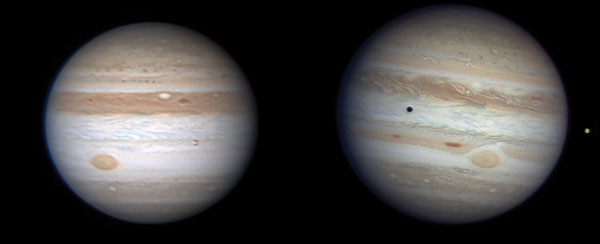In the small hours of the morning, even before the sun is up, a bright star is rising. This is Jupiter.
If you look closely, you’ll see white stripes and dark bands the color of L.A. smog. Usually, two enormous belts flank the equator like rust-colored tire tracks. But now something is different.
One of the belts is missing. And no one really knows why.
“(Jupiter is) an incredibly turbulent, rapidly rotating body,” said Jonathan Aurnou, an associate professor of planetary physics.
This isn’t the first time the band has gone missing. The Southern Equatorial Belt disappears every 10 to 15 years, most recently in 2007. This time around, amateur astronomers with powerful telescopes first noticed the absence in early May.
Some think that a higher layer of white, wispy cirrus clouds similar to those on Earth are veiling the lower layers, said Jonathan Mitchell, an assistant professor of planetary science.
This change might be caused by a significant disruption in the atmosphere, said Jean-Luc Margot, an associate professor of planetary science.
Since only the southern belt disappears, the Great Red Spot may be the culprit, said Gerald Schubert, a professor of geophysics and planetary physics. A swirling, hurricane-like vortex, the Spot sits on the southern belt and perturbs the atmospheric system. Yet the characteristic spot has remained curiously stable for more than 400 years.
Though by far the largest planet in the solar system, Jupiter is no gentle giant. Harboring winds can reach up to 384 miles per hour. These winds blow in opposite directions and stretch into bands as Jupiter rotates quickly.
“All of those bands that you’re used to seeing on the visible surface of Jupiter are really fast storms. Certain areas will churn up different materials,” said Britney Schmidt, a doctoral student in earth and space sciences and former president of the Earth and Space Sciences Student Organization.
These chemicals condense at different temperatures, creating several deep layers of clouds, Margot said. The closer to Jupiter’s core, the hotter the temperature.
In fact, the dark bands are made up of similar chemicals to the thick orange haze that airplanes pass through on their way to and from Los Angeles International Airport, Mitchell said. But the depth of these clouds still remains an enigma.
“When you’re looking at the surface of Jupiter, you’re basically watching physics work,” Schmidt said.
Eventually, the southern belt will return to normal, though no one knows exactly when. At first, a little spot of dark will poke through the white clouds, spreading rapidly as the entire band reappears, Mitchell said.
For those who want to observe the belt’s dramatic return, Jupiter should be rising at night by the end of the summer, according to Ian Crossfield, a graduate student in astronomy. The planet is easily visible through the telescopes at the UCLA Planetarium, which holds shows and telescope viewings every Wednesday at 8 p.m.
With all the mysteries swirling around the planet, Jupiter continues to spark the interest of planetary scientists in the earth and space sciences department.
“This is the Cadillac of the solar system,” Aurnou said.
